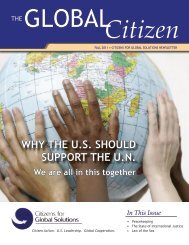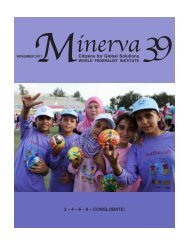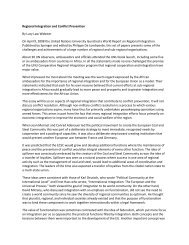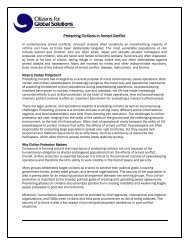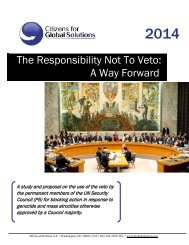Minerva, Spring 2008 (Volume 32) - Citizens for Global Solutions
Minerva, Spring 2008 (Volume 32) - Citizens for Global Solutions
Minerva, Spring 2008 (Volume 32) - Citizens for Global Solutions
You also want an ePaper? Increase the reach of your titles
YUMPU automatically turns print PDFs into web optimized ePapers that Google loves.
Various civil society ef<strong>for</strong>ts have aimed to raise general awareness of the responsibility<br />
to protect. The World Federalist Movement’s New York Institute <strong>for</strong> <strong>Global</strong> Policy<br />
has sponsored one of the more prominent civil society networks aimed at “advancing<br />
responsibility to protect and to promote concrete policies to better enable governments,<br />
regional organizations and the UN to protect vulnerable populations”. A number of<br />
consultations have also taken place across Africa, engaging a wide range of civil society<br />
organizations, governments and officials from the African Union and other regional<br />
organizations. In May 2007, a <strong>for</strong>um of NGOs <strong>for</strong>mally called upon the African Commission<br />
on Human and Peoples’ Rights to endorse the responsibility to protect. Other<br />
consultations in Asia and the Middle East have grappled with the issue of how to translate<br />
the principles into regional contexts and how to overcome cultural or structural<br />
barriers to implementing these principles. A recent upsurge of interest in the US has<br />
led to a series of conferences and ef<strong>for</strong>ts to build a coalition geared toward shaping US<br />
policy on prevention of genocide and crimes against humanity.<br />
Research organizations in Europe, Africa and North America have contributed to developing<br />
a better understanding of the operational implications of the responsibility<br />
to protect. A groundbreaking study by the Henry L. Stimson Center on military preparedness<br />
<strong>for</strong> conducting protection operations identified clear gaps that need to be<br />
addressed “if aspirations to protect civilians are to transcend rhetoric and translate<br />
into effective action in the field”. 25 This research led to a three-day workshop with<br />
senior military commanders that identified lessons learned and developed operational<br />
concepts <strong>for</strong> preventing or stopping mass atrocities. Other research has looked at how<br />
regional organizations such as the African Union could better integrate responsibility<br />
to protect principles into their work programmes.<br />
While the above activities have resulted in increased awareness about the responsibility<br />
to protect and contributed significantly to policy development, a number of organizations<br />
have identified the need <strong>for</strong> a clearer focal point <strong>for</strong> this work in order to<br />
develop strategies <strong>for</strong> moving this agenda <strong>for</strong>ward. To this end, the International Crisis<br />
Group teamed up with a number of NGOs and supportive governments to establish the<br />
<strong>Global</strong> Centre <strong>for</strong> the Responsibility to Protect. The Centre aims to be a resource base<br />
and catalyst <strong>for</strong> ongoing activity worldwide by NGOs, governments and key international<br />
organizations. It was officially launched in February <strong>2008</strong> with an ambitious<br />
agenda: 1) advance and consolidate the World Summit consensus on R2P; 2) protect<br />
the integrity of the R2P concept; 3) clarify when non-consensual military <strong>for</strong>ce can and<br />
cannot be used consistently with R2P principles; 4) build capacity on R2P within international<br />
institutions, governments, and regional organizations; and 5) have in place<br />
the mechanisms and strategies necessary to generate an effective political response as<br />
new R2P situations arise. 26 The success of the Centre and its network of associates will<br />
undeniably hinge on its ability to attract sustained support in order to deliver on what<br />
is arguably a very long-term agenda.<br />
Footnotes 25–27:<br />
25 See Holt and Berkman, The Impossible<br />
Mandate.<br />
26 See www.globalcentrer2p.org<br />
27 Address by Gareth Evans, President,<br />
International Crisis Group, to Human<br />
Rights Law Resource Centre (Melbourne:<br />
13 August 2007), and Community<br />
Legal Centres and Lawyers <strong>for</strong><br />
Human Rights (Sydney: 28 August 2007)<br />
[available at www.crisisgroup.org].<br />
THE IMPORTANCE OF WOMEN’S LEADERSHIP<br />
First and <strong>for</strong>emost, giving “real meaning” to the responsibility to protect will require<br />
concerted ef<strong>for</strong>t to deepen the international commitment endorsed by the 2005 Summit<br />
and to establish it firmly as a norm of international law. The potential <strong>for</strong> backsliding<br />
on the summit consensus presents an ongoing danger:<br />
For whatever reason – embarrassment about their own behaviour, embrace of<br />
the concept but concern about its misuse, or ideological association of any<br />
intervention with neo-imperialism or neo-colonialism – there is a recurring<br />
willingness by a number of states to deflate or undermine the concept. 27<br />
If the responsibility to protect is to have any meaning at all, it will need to be promoted<br />
in such a way that it does not get unnecessarily diluted. Since the 2005 Summit, there<br />
has been a tendency to apply the “responsibility to protect” as a catchphrase to a wide<br />
19 • <strong>Minerva</strong> #<strong>32</strong> • June <strong>2008</strong>



